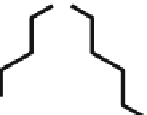Biomedical Engineering Reference
In-Depth Information
a
b
O
O
O
O
n
n
N
H
2
+
Cl
-
NH
2
c
O
O
O
O
R
X
R
or
N
N
N
O
O
O
O
n
n
R'
R''
R
'
d
e
O
OH
O
O
P
O
O
O
P
y
P
O
x
N
O
O
O
n
NH
2
NH
3
+
Cl
-
NH
2
f
N
N
HN
O
or
P
N
P N
n
n
HN
O
N
N
Fig. 4
Biodegradable synthetic polycations: (
a
) poly[a-(4-aminobutyl)-L-glycolic acid] (PAGA),
(
b
) poly(4-hydroxy-L-proline ester) (PHP), (
c
) poly(b-amino ester)s, (
d
) poly(2-aminoethylpro-
pylene phosphate) (PPE-EA), (
e
) polyphosphoramidate (PPA), and (
f
) cationic polyphosphazenes
condense pDNA to form nanoscaled polyplexes which were able to completely
dissociated within one day of incubation at 37°C due to the degradation of PAGA
(Lim et al.
2000a
). PAGA showed about 2-fold higher transfection efficiency than
PLL, while no measurable cytotoxicity was detected in the concentration range of
experiments.
In vivo
study using nonobese diabetic (NOD) mice showed the sus-
tained mIL-10 expression for 9 weeks post-systemic administration of PAGA-
pDNA (encoding murine interleukin-10, mIL-10) nano-polyplexes (Koh et al.
2000
).
In addition, the prevalence of severe insulitis on 12 week-old NOD mice was


















































Search WWH ::

Custom Search